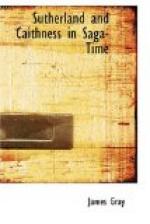What manner of men the prehistoric races which in early ages successively inhabited the northern end of the Scottish mainland may have been, we can now hardly imagine. Dr. Joseph Anderson’s classical volumes[1] on Scotland in Pagan Times tell us something, indeed all that can now be known, of some of them, and in the Royal Commission’s[2] Reports and Inventories of the Early Monuments of Sutherland and of Caithness respectively, Mr. Curle has classified their visible remains, and may, let us hope, with the aid of legislation, save those relics from the roadmaker or dykebuilder. Lastly, such superstitions, or survivals of beliefs, as remain in the north of Scotland from early days have been collected, arranged, and explained by the late Mr. George Henderson in an able book on that subject.[3] Enquiries such as these, however, belong to the provinces of archaeology and folk-psychology, and not to that of history, still less to that of contemporary history, which began in the north, as elsewhere, with oral tradition, handed down at first by men of recording memories, and then committed to writing, and afterwards to print; and both in Norway and Iceland on the one hand, and in the Highlands on the other such men were by no means rare, and were deservedly held in the highest honour.
Writing arrived in Sutherland and Caithness very late, and was not even then a common indigenous product. Clerks, or scholars who could read and write, were at first very few, and in the north of Scotland hardly any such were known before the twelfth century of our era, save perhaps in the Pictish and Columban settlements of hermits and missionaries. Of their writings, if they ever existed, little or nothing of historical value is extant at the present time. But the Orkneyinga, St. Magnus, and Hakon’s Sagas, when they take up their story, present us with a graphic and human and consecutive account of much which would otherwise have remained unknown, and their story, though tinged here and there with romance through the writers’ desire for dramatic effect, is, so far as the main facts go, singularly faithful and accurate, when it can be tested by contemporary chronicles.
Until the twelfth or the thirteenth century, save for these Sagas, we learn hardly anything of Sutherland, or, indeed, of the extreme north of Scotland from any record written either by anyone living there or by anyone with local knowledge, and for facts before those given in the Orkneyinga Saga we have to cast about among historians of the Roman Empire and amongst early Greek geographers, or later ecclesiastical writers, to find nothing save a few names of places and some scattered references to vanished races, tongues and Churches. For information about the Picts we have at first to rely on the researches of some of our trustworthy archaeologists, and at a later date on the annals, largely Irish, collected by the late Mr. Skene in his Chronicles of the Picts and Scots,




